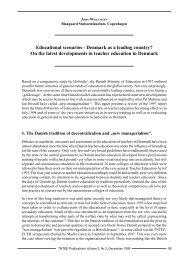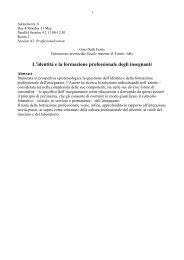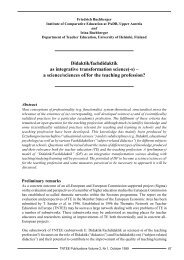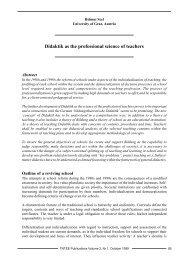TNTEE Publications - Didaktik/Fachdidaktik
TNTEE Publications - Didaktik/Fachdidaktik
TNTEE Publications - Didaktik/Fachdidaktik
Create successful ePaper yourself
Turn your PDF publications into a flip-book with our unique Google optimized e-Paper software.
The Deutsche <strong>Didaktik</strong> and the American Research on Teaching<br />
and to determine those factors which are crucial in planning and acting in the teaching process. In<br />
this way research is also connected with teacher education.<br />
On the theoretical level, the development of theoretical models has concentrated on empirical research<br />
and on testing these in real situations. Mastery learning in particular, based on the ideas of John B.<br />
Carroll and Benjamin S. Bloom, is well known in this respect. Bruce Joyce and Marsha Weil have<br />
collected the various philosophical and psychological strategies and formulated applications to<br />
teaching.<br />
Most of the research on teaching has been empirical and with quantitative methods. The latest<br />
developments, however, have led to alternative approaches. The most commonly used processproduct-paradigm<br />
is not as dominant as it was earlier and studies with qualitative research methods<br />
have greatly increased. The theoretical background to the discussion of research problems is clearly<br />
research methodology which leads to other philosophical questions.<br />
Some preliminary conclusions<br />
Comparison of terminology<br />
Die <strong>Didaktik</strong> – didactics<br />
Didactics (die <strong>Didaktik</strong>) is a difficult term to use. Its origin is an applied translation from Greek<br />
meaning both teaching and learning (Heursen 1986, Knecht-von Martial 1985). Wolfgang Ratke<br />
and Johan Amos Comenius were the founders of this terminology and the first to launch the term in<br />
their writings, but <strong>Didaktik</strong> was an artificial term in a certain way. The respective family of words in<br />
Greek was not translated with a German word but with an application of the original didáskein via<br />
Latin didactica, which was also artificial. Its very first meaning was about the same as the art of<br />
teaching or Lehrkunst.<br />
Die <strong>Didaktik</strong> was gradually taken into more general use alongside die Pädagogik or pedagogics,<br />
but its use was limited to German-speaking countries or to countries having cultural relations with<br />
Germany. As a result, <strong>Didaktik</strong> is nowadays in use in Central Europe and in the Scandinavian<br />
countries, but it is practically unknown at least in English- or French-speaking countries in the area<br />
of education. The very word can be found in dictionaries with quite different meanings, however. It<br />
is based on didascalia having the meaning of a didactic poem (Blankertz 1975, 14), and that makes<br />
its use most awkward and disturbing.<br />
What then is the proper translation of <strong>Didaktik</strong>? (cf. also Kansanen 1987). If we emphasise the<br />
normative side of <strong>Didaktik</strong>, the most convenient descriptionwould be the art of teaching. This<br />
expression, however, already has its own context (cf. Gage 1978). But if we want to keep the<br />
definition as wide as <strong>Didaktik</strong> is nowadays, the art of teaching is too narrow because there is no<br />
reference to learning in its meaning. Naturally, there are various interpretations of teaching (cf.<br />
Smith 1987, including older references), but what is essential in this analysis is that <strong>Didaktik</strong> is at<br />
the same time a second order term. It is thus a model or a system of how to envisage the teachinglearning<br />
process as well as a kind of metatheory where the various models can be compared with<br />
each other.<br />
If we emphasise the descriptive side of <strong>Didaktik</strong>, the research aspects come to the fore in its content.<br />
Then the proper expression would be research on teaching. If we look into the well-known research<br />
models of Mitzel, Dunkin and Biddle, and Shulman, the aspects of learning can also be seen there.<br />
The difference between the descriptive <strong>Didaktik</strong> and research on teaching is in their background or<br />
in the purpose of their model building. The first, <strong>Didaktik</strong>, is mainly meant for teacher education<br />
<strong>TNTEE</strong> <strong>Publications</strong> Volume 2, Nr 1, October 1999 23








